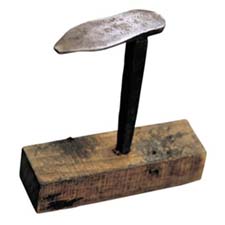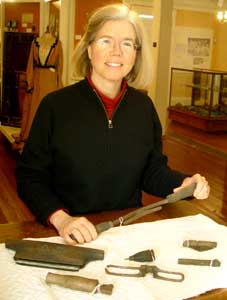| Lost Shoemaker Art Uncovered |

OLD BERWICK COUNTING HOUSE
When Nina Maurer began cataloguing artifacts from the Old Berwick Historical Society earlier this year, the South Berwick resident opened a new window into the town’s manufacturing past.(Click to read full story)
South Berwick Museum Explores Cobbler’s Craft
Examining the society’s collection of 500 objects, Nina Maurer learned that many were once used to assemble and repair shoes in the 1800s. A cottage shoe-making industry was prevalent in 19th-century South Berwick. Some cobblers worked in the village center and at the river landing, others were based in rural outposts.
Although the region’s well-known history with shoe factories and tanneries lasted well into the 20th century, many of the tools Maurer identified came from lesser-known small shops and not from the massive shoe factories that came to the Berwicks later in the 19th century.
"These tools describe a time, a hundred years ago and more, when South Berwick was a village in a largely agricultural community," said Maurer, as she held up some of the strange-looking wooden tools kept at the historic Counting House Museum at the edge of downtown South Berwick.
 One tool was misidentified by its donor as a ship rigging tool, she noted. In looking through a book about the leather trade, Maurer found the exact tool described as a sleeking iron used to polish the top of boots and seal the leather.
One tool was misidentified by its donor as a ship rigging tool, she noted. In looking through a book about the leather trade, Maurer found the exact tool described as a sleeking iron used to polish the top of boots and seal the leather.
The shoe-making tools, some of them patented, represent the early transition of this region from an agricultural to an industrial economy. Many of the farms in the area were not self-sufficient and people who had to piece together an income had cottage businesses in their yards. Some farms had small shops devoted to repair and assembly of shoes that used leather imported from Massachusetts. In particular, Maurer said, the town seemed to have a close relationship with the city of Lynn, Massachusetts.
Once Maurer identified the tools through reference books and communications with other experts, she began to research this part of the region’s past. In a story by South Berwick author Sarah Orne Jewett, "The Failure of David Berry," she found a masterful reference to just this sort of cottage industry:
"Mr. David Berry kept his shop in a small wooden building in his own yard, and worked steadily there a great many years, being employed by a large manufacturing company in Lynn at soling and heeling men's boots. There were many such small shoe shops as his scattered among the villages and along the country roads. Most of the farmers knew something of the shoemaking trade, and they and their sons worked in their warm little shops in winter when they had nothing else to do, and so added a good deal of ready money to their narrow incomes."
Maurer, who has worked as a curator of maritime and early American collections with the Connecticut River Museum in Essex, Connecticut, and the Mercer Museum in Doylestown, Pennsylvania, was hired by the historical society in the spring of 2007 to catalog and photograph 500 tools, textiles, household artifacts, nautical instruments, paintings and other objects from the 19th and early 20th centuries. The objects had been donated to the society’s Counting House Museum over the 40 years since the society was formed.
"There were about 40 items that we could not identify," said Wendy Pirsig, president of the society. "We were thrilled to discover this common link between them and this paved pathway to our town’s industrial past."
Now about three-quarters of the way through the project, Maurer said her work has also yielded new information about other parts of the collection. For example, she learned that the society’s spinning wheel had a patented accelerator wheel head to speed the yarn spinning process, and it was made by S.S. Campbell & Son in Chesterfield Falls in southwestern New Hampshire. Sidney S. Campbell is listed as a retired manufacturer in the town's 1884 business directory.
The money to pay for the cataloguing project came through in 2007 when the Davis Family Foundation donated $7,500 and the Collections Grants Program of the Maine New Century Community Program donated $5,000.
Maurer, who lives in a 130-year old house in South Berwick, expects to be done by next spring. For each of the museum objects, she has been unpacking, cleaning, and measuring the item; identifying and numbering it; describing it on the historical society database in terms of materials, size, date, use, provenance, category, location, exhibit/loan history, and references; and photographing it and downloading the image to the data file.
In many ways, the cottage industry Maurer uncovered through these tools mirrors the challenges of many people who chose to live in Maine today.
"In my mind," she suggested, "we are still trying to piece together a living in this village with rural surroundings."
The cataloging project will allow the society to have permanent records, including photos, of all objects in the collection. In addition to the 500 objects documenting life in this region after 1800, the society has a collection of 40,000 archaeological artifacts excavated by Dr. Emerson Baker since 1995 at the 17th-century Humphrey Chadbourne homesite in South Berwick.
The society’s collection is the most complete public collection of objects and archives reflecting life of the 17th through early 20th centuries in southwestern York County. It has been run for 40 years by volunteers.
The Counting House Museum is open weekend afternoons in summer and fall, and year-round by appointment by contacting (207)384-0000 or This email address is being protected from spambots. You need JavaScript enabled to view it..
